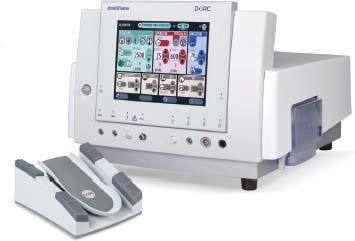Spotlight ON TECHNOLOGY & TECHNIQUE
Phaco-Vitrectomy Combo Puts Safety First
By Samantha Stahl, Assistant Editor
The needs of retinal surgeons are a bit like those of automobile enthusiasts, says Peter Stalmans, MD, of Belgium. While everyone wants a fast, precise performer like a Ferrari, doctors also need a machine built for safety, much like a 4x4 that "keeps us on the road when unexpected things happen during surgery."
The Associate device from DORC takes the best components from each "vehicle" and delivers them in one neat package, according to those familiar with its use. With a single machine, surgeons have the tools to perform vitrectomy and, with the flip of a switch, phaco procedures. The Associate features both a peristaltic and venturi pump to accommodate the needs of anterior and posterior segment procedures.
Safe at Any Speed
Dr. Stalmans says the best feature of the system is the increased safety for his patients, particularly those with detached retina and adherent hyaloid.
The venturi pump generates a linear vacuum at the tip of the cutter. The flow rate is dependent on the resistance of the aspirated material. When the tip is moved out of the vitreous gel, more irrigating solution is aspirated, raising the flow rate and also the risk for aspiration of a detached retina, Dr. Stalmans says. This is when the Associate's peristaltic pump comes in handy.
Used for vitreous base shaving, the peristaltic pump's linear flow is controlled by the vitrectomy machine rather than the resistance in the tubing, explains Dr. Stalmans. As the vitrectome moves in and out of the vitreous gel, the flow rate will stay the same. Although the cutter works closely to the retinal surface, the retina hardly moves, meaning a lower risk for unintended retinal break formation, he says. The peristaltic pump doesn't require a higher cut speed to stabilize the retina.

The Associate from DORC is capable of performing both phaco and vitreoretinal procedures.
In venturi phaco mode, two vacuum levels can be programmed — low range and high range. The system will limit vacuum amount at the phaco tip in the low-range setting. However, if a lens fragment comes in contact with the tip, the system will automatically switch to a high-range vacuum to aspirate lens particles. Once the occlusion breaks, the vacuum will switch to low range. "This avoids a high fluid aspiration, resulting in a stable anterior chamber and low risk of lens capsule aspiration," says Dr. Stalmans.
While most of the Associate's features have next to no learning curve, the optional dual linear foot pedal does take some getting used to, says Dr. Stalmans, but is beneficial for optimal surgery control. The pedal's functions can be customized so that pressing up or down may control aspiration, while left and right action controls cut speed or phaco power.
The system can also control intraocular pressure during vitrectomy, which Dr. Stalmans compares to water in a tub. "The fluid amount in a bathtub is dependent on two factors — the amount coming out of the tap and the amount removed through the drain. The same is true in the eye during surgery," he says. The fluidics depend on the infusion line's inflow and outflow from the vitrectomy machine's vacuum.
DORC is also evaluating a feature that will allow the Associate to generate an IOP compensation level based on the vitrectome's vacuum and cut speed. For example, if a base pressure of 20 mm Hg is generated in the infusion bottle, then "when vacuum is increased from 0 to 350 mm Hg, simultaneously an additional pressure of up to 40 mm Hg is generated in the infusion system," Dr. Stalmans explains. The higher outflow is balanced by higher infusion, resulting in stable IOP. This feature should be available next year, he says.
Simon Prosser, surgical equipment sales and project manager for DORC, says dual-pump technology has been popular in Europe for a long time, but only recently migrated over to the states. The compact package uses LED illumination that lasts up 10,000 hours, and the 20-, 23-, 25- and 27-gauge entry systems all come with unique removable valves and high flow vitrectomes.
"The Associate is much smaller than most US machines," Mr. Prosser says. "When people look at it, they say, ‘That cannot do everything.’ Yet it does." OM
For more information, visit www.dorc.nl.








